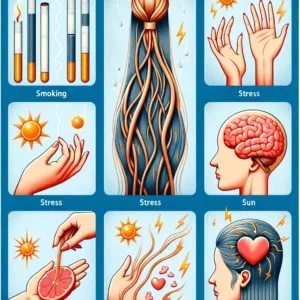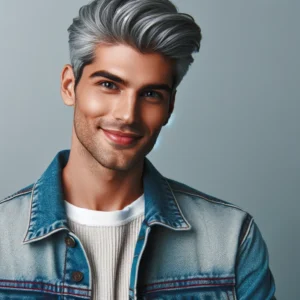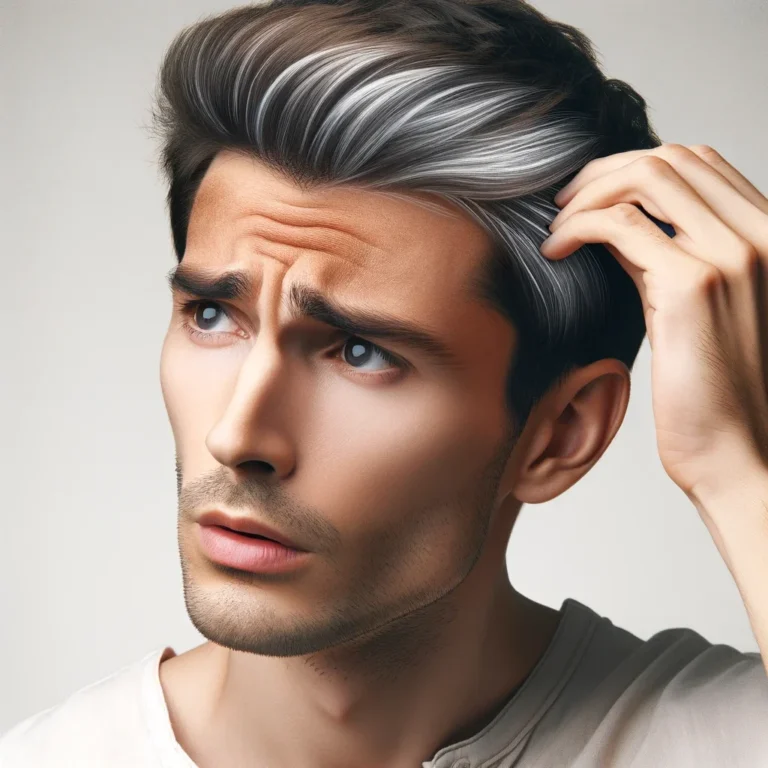Imagine looking in the mirror and seeing a strand of gray hair. Now imagine that happening when you’re only 25 or even less.
How would you feel? Shocked? Annoyed? Worried? You’re not alone.
Many people experience premature graying of hair, which can affect their self-esteem and confidence. But what causes this phenomenon, and can it be prevented or reversed?
In this article, we’ll explore the science behind premature graying and the options you have to deal with it. By the end of this article, you’ll have a clearer understanding of your hair color and how to embrace it.
When Premature Graying Comes to Play
A sprinkling of silvery strands in your mane is a natural part of growing older. Yet genetics, environment, and lifestyle habits nudge some down the gray path sooner than others.
When does premature graying begin? Experts pinpoint the premature zone as:
- Whites: Before age 20
- Asians: Before 25
- Blacks: Before 30
Smoking, high stress, vitamin deficiencies, autoimmune disorders, and thyroid disease can also usher in premature grays.
Yet despite greying early, your lifespan remains unaffected. While gray hairs may signal wisdom, they aren’t a countdown to your expiration date.
Now let’s explore what makes hair turn gray in the first place.
Demystifying Gray Hair’s Origins
What transforms a lush mane into a silvery crown? The main culprit is melanin – or rather, a lack thereof.
Melanin Gives Hair Its Pigment
Melanin is the pigment that colors your hair, eyes, and skin. The melanin-producing cells that give your locks their hue are aptly called melanocytes. They reside in the hair follicle – the part of the hair that sits within the scalp skin.
Melanocytes work tirelessly to pump out melanin so your hair maintains rich, consistent coloration. But over time, these melanin factories begin to sputter.
Gray Hair Has Less Melanin
As you age, melanocytes slack off on melanin production. Individual hairs grow in with less pigment, creating a silvery-gray appearance.
Eventually, the melanocytes stop producing melanin completely. And voila – your hair turns snowy white from root to tip!
So in essence:
- Gray hair = some melanin
- White hair = no melanin
Now let’s look at why melanin fades faster for some.
Why Do Some Gray Early?

While graying is inevitable, why do some folks go gray years or even decades before others? Here are the main contributing factors:
Genetics
Some are simply dealt a genetic hand prone to premature graying. If your parents went gray early, you have increased odds of following suit.
Scientists believe melanocyte stem cells may have a predetermined lifespan – essentially an expiration date. For genetic grayers, these cells perish ahead of schedule.
Certain hereditary conditions can also accelerate graying:
- Albinism: Characterized by lack of melanin production altogether. Those with albinism often have pale white skin and hair at birth.
- Chédiak-Higashi syndrome: A rare immunodeficiency disease that can cause premature graying.
- Griscelli syndrome: This rare genetic disorder appears in infancy and causes light hair color.
- Waardenburg syndrome: Distinguished by a white forelock of hair and lack of skin pigmentation.
Environment & Lifestyle
Environmental influences and lifestyle choices may also spur premature graying:
- Smoking: Long-term smoking corrodes health in numerous ways, including speeding up graying.
- Sun exposure: UV radiation can damage melanocytes, reducing melanin output.
- Pollution: Toxins and metals in polluted air may impact melanin production.
- Stress: Some research links chronic stress to premature graying. Stress-induced free radical damage may impair melanocyte stem cells.
Health Conditions
Certain medical conditions are linked with early graying as well:
- Vitamin B12 deficiency: Pernicious anemia impairs vitamin B12 absorption, which may accelerate graying.
- Autoimmune disorders: Conditions like vitiligo attack and destroy melanocytes.
- Thyroid disorders: Both overactive and underactive thyroid have been associated with premature gray hair.
Bottom line: Our genetics, environmental exposures, and overall health influence when gray begins its slow takeover.
Now let’s look at ways to potentially push back the gray.
Can Gray Hair Be Reversed?
If you’re just starting to go gray, there’s a bit of hope. One study showed that when stress was eliminated, participants’ hair partially recovered its original color – temporarily, at least.
The proposed mechanism? Removing stress meant less free radical damage so melanocyte stem cells could briefly rebound.
But don’t expect miracles. If you’ve been gray for years, the melanocyte decline likely can’t be reversed. At some point, aging certainties catch up with us all.
The takeaway?
Don’t obsess over grays. Manage stress and live healthier to potentially slow premature graying. But also embrace the new you – because with age comes wisdom.
Here’s an overview of tactics for restoring your former hue:
Reduce Stress
If you’re in the early graying stages, stress relief may help restore some pigment.
Research shows dialing down stress can temporarily return hair to its original color – at least for a time. One study found study participants’ hair recovered its pigment after a vacation.
But don’t expect miracles. If you’ve been gray for years, your melanocyte factories are likely too far gone for a stress break to restart meaningful melanin production.
Treat Underlying Medical Conditions
Getting properly diagnosed and addressing conditions like thyroid disorders, anemia, or vitiligo may help slow down premature graying.
Discuss any concerns over rapid graying with your doctor. Treating the underlying illness may sustain melanocytes and color for longer.
Consider Supplements
Some research has explored vitamins, minerals, and antioxidant supplements as possible gray-fighters:
- Vitamin B12: This may help for those with pernicious anemia.
- Biotin: Small studies show biotin (vitamin B7) supplements may reduce hair shedding and support re-pigmentation.
- Catalase: This antioxidant enzyme may help protect melanocytes from hydrogen peroxide damage.
- Melanin precursors: Compounds like copper help support melanin synthesis.
Discuss any supplements with your doctor before use, including safety and proper dosing. While a daily multivitamin is generally fine, megadosing certain vitamins can have risks.
Give Topical Remedies a Try
Some over-the-counter products claim to slow graying. No products can reverse gray permanently, but some may help modestly boost pigment:
- Melanin precursors: Topicals with copper, zinc, or other precursors may mildly stimulate melanin production.
- Antioxidants: Vitamin E, rosemary, and sage applied topically may protect against oxidative melanocyte damage.
- Plant oils: Black cumin seed oil, black tea, rosemary oil, and onion juice may provide subtle darkening.
- Staining agents: Temporary darkening products like mascara, hair dye, or rinses can mask grays until your next shampoo.
While topical remedies are unlikely to work miracles, they may provide a slight pigment pick-me-up and delay the inevitable silver surge.
Embracing the Gray

While you can take steps to potentially stem the tide, graying remains a natural part of the aging process. At some point, the melanin decline becomes irreversible.
Rather than an adversary, view gray hair as a distinguished badge of honor representing your life experience. Those silver streaks have been earned through years of chasing dreams, raising families, forging careers, and writing your story.
Gray hair imparts gravitas, sophistication, and perspective. And today’s expanding palette of flattering hair colors makes embracing the silvers both fun and fashionable.
You have decades of wisdom and untapped potential ahead. So take pride in your gray – and know your best years still lie before you.

